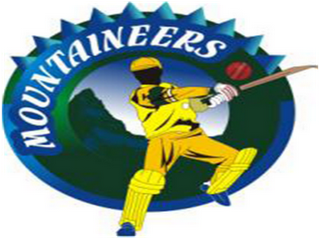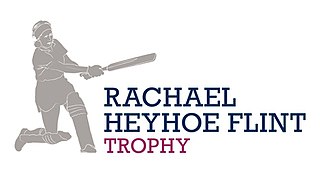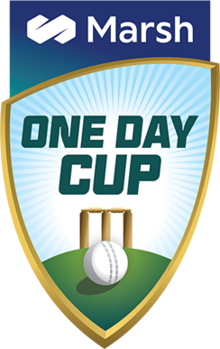
The Cricket World Cup is the international championship of One Day International (ODI) cricket. The event is organised by the sport's governing body, the International Cricket Council (ICC), every four years, with preliminary qualification rounds leading up to a finals tournament. The tournament is one of the world's most viewed sporting events and considered the "flagship event of the international cricket calendar" by the ICC. It is widely considered the pinnacle championship of the sport of cricket.

The ICC Champions Trophy, also called the "Mini World Cup" or simply "Champions Trophy" is a quadrennial cricket tournament organised by the International Cricket Council. Inaugurated in 1998, The ICC conceived the idea of the Champions Trophy – a short cricket tournament to raise funds for the development of the game in non-test playing countries. It can be compared to FIFA Confederations Cup in football. It remains as one of those ICC events that had the same format as that of another big cricketing event, like the Cricket World Cup, with the format being One Day Internationals. The tournament is one of the world's most viewed sporting events.

Twenty20 (T20) is a shortened format of cricket. At the professional level, it was introduced by the England and Wales Cricket Board (ECB) in 2003 for the inter-county competition. In a Twenty20 game, the two teams have a single innings each, which is restricted to a maximum of twenty overs. Together with first-class and List A cricket, Twenty20 is one of the three forms of cricket recognised by the International Cricket Council (ICC) as being played at the highest level, both internationally and domestically.

The Sheffield Shield is the domestic first-class cricket competition of Australia. The tournament is contested between teams representing the six states of Australia. The Sheffield Shield is named after Lord Sheffield.

The CSA 4-Day Domestic Series is the domestic first class cricket competition of South Africa. The tournament is contested by teams from all nine provinces of South Africa.

The Australian women's national cricket team represent Australia in international women's cricket. Currently captained by Alyssa Healy and coached by Shelley Nitschke, they are the top team in all world rankings assigned by the International Cricket Council (ICC) for the women's game.
International cricket in the 2006–07 cricket season is defined by major statisticians, such as CricketArchive and Wisden, as those matches played on tours that started between September 2006 and April 2007. Two major ICC tournaments are scheduled for this season, with the Champions Trophy played in October in India, and the World Cup taking place in West Indies in March. In addition, England will defend the Ashes when they go to Australia in November, and all the ten Test nations will be in action during November and December – though Zimbabwe, who are playing Bangladesh during this time, withdrew from Test matches throughout 2006 and will thus only be playing One-day International matches.

The Mountaineers is one of five cricket Zimbabwean cricket franchises. They are a first-class cricket team, based in the Manicaland and Mashonaland East area. They play their home matches at Mutare Sports Club in Mutare.

Jason Paul Behrendorff is an Australian cricketer, currently listed with Western Australia and the Perth Scorchers in Australian domestic cricket. He plays for Mumbai Indians in the Indian Premier League and Major League Cricket.
Kurtis Robert Patterson is an Australian cricketer who plays for the New South Wales cricket team in the Sheffield Shield, and the Sydney Sixers in the Big Bash League. Patterson scored a century on his first-class cricket debut for New South Wales in November 2011, becoming the youngest batsman to score a century in Sheffield Shield cricket. In January 2019, he made his Test debut for Australia against Sri Lanka, becoming the 457th person to play test cricket for Australia. He made a century in just his second test match in Canberra, also against Sri Lanka. He was not selected for the 2019 Ashes series and returned to play domestically in the 2019/2020 season. He has the highest average of any Test batsman who has lost their wicket at least once.
Hilton William Raymond Cartwright is a Zimbabwean born Australian international cricketer who plays for Western Australia and the Melbourne Stars. He is a right-handed all-rounder. Cartwright made his Test debut for the Australian national team in January 2017, having earlier played for Australia A and the National Performance Squad. In January 2017 he won the Bradman Young Cricketer of the Year prize awarded by Cricket Australia.
Alexander Ian Ross is an Australian cricketer. The son of a cricket coach, Ross started playing domestic cricket for South Australia in 2012, having moved to the state in 2009 with his father. He began to rise to prominence in the 2014–15 season when, after improved form in both first-class and List A cricket, he began playing for the Adelaide Strikers in the Big Bash League. In his first match of BBL|05 he scored 65 runs off 31 balls, making excellent use of the sweep shot and earning the moniker "sweepologist". He currently represents South Australia in first-class and one-day cricket and plays for the Sydney Thunder in the Big Bash League.

Scott Michael Boland is an Australian international cricketer. A right-arm fast-medium bowler, he also plays domestically for Victoria and the Melbourne Stars. In March 2019, he was named the Sheffield Shield Player of the Year by Cricket Australia. Boland is one of a handful of Indigenous Australians to be selected to play for Australia at international level and, as of December 2021, is only the second male Aboriginal player to have played Test cricket for Australia, after Jason Gillespie. He was a member of the Australian team that won the 2023 ICC World Test Championship final.

The Women's Big Bash League is the Australian women's domestic Twenty20 cricket competition. The WBBL replaced the Australian Women's Twenty20 Cup, which ran from the 2007–08 season through to 2014–15. The competition features eight city-based franchises, branded identically to the men's Big Bash League (BBL). Teams are made up of current and former Australian national team members, the country's best young talent, and up to three overseas marquee players.

The Women's Cricket Super League (WCSL), known as the Kia Super League (KSL) for sponsorship reasons, was a semi-professional women's Twenty20 cricket competition in England and Wales operated by the England and Wales Cricket Board (ECB). The competition featured six franchise teams, partnered with a variety of county teams and boards and universities, and was envisaged as a means to bridge the gap between amateur domestic cricket and the increasingly professional international game.

The Southern Vipers were a women's cricket team that represented the South of England. The Vipers wore an orange and black kit and primarily played their home matches at the Rose Bowl and the County Ground, Hove.

Western Storm were a women's cricket team that represented South West England and Wales, one of eight regional hubs in English domestic cricket. They primarily played their home matches at the County Ground, Taunton, the County Ground, Bristol and Sophia Gardens. They were captained by Sophie Luff and coached by Trevor Griffin. The team were partnered with Somerset, Gloucestershire, Glamorgan, Devon, Cornwall, Wiltshire and Cricket Wales. Originally formed to compete in the Women's Cricket Super League in 2016, Western Storm won the competition twice, in 2017 and 2019. When women's cricket in England was reformed in 2020, the Western Storm brand was retained, and they competed in the Rachael Heyhoe Flint Trophy and the Charlotte Edwards Cup.

The Rachael Heyhoe Flint Trophy was an English and Welsh women's cricket domestic competition, named after former England captain Rachael Heyhoe Flint, who died in 2017. The first edition of the tournament took place during August and September 2020, with the Southern Vipers beating the Northern Diamonds in the final. Initially started as a one-off tournament, in February 2021 the England and Wales Cricket Board (ECB) announced it would return for the 2021 season as a permanent part of the women's domestic structure in England and Wales, alongside the Charlotte Edwards Cup. The final edition was played in 2024, with the ECB announcing it would be replaced by a new One-Day Cup as part of a restructuring of women's domestic cricket in England and Wales.
The Fifty50 Challenge is a women's domestic one-day cricket competition organised by Zimbabwe Cricket. The competition began in the 2020–21 season, and sees four teams competing in 50-over matches.
The Women's T20 Cup is a women's domestic Twenty20 competition organised by Zimbabwe Cricket. The competition began in the 2020–21 season, and sees four teams competing.

















